Laptop Mag Verdict
The Samsung Gear 2 has a sleeker design than its predecessor and a built-in heart-rate monitor, but it doesn't save you enough time for the price.
Pros
- +
Good call quality
- +
Durable, attractive design
- +
Colorful display
- +
Loud and clear voice calls
- +
Convenient remote-control app
Cons
- -
Screen doesn't stay lit
- -
Expensive
- -
Few apps
- -
Difficult wrist strap
- -
UI requires too many swipes
Why you can trust Laptop Mag
Time flies when you're Samsung. Just half a year after the Korean company shipped its first smartwatch -- the Galaxy Gear -- Samsung has rolled out its next smartwatch, the Gear 2. Like its predecessor, the Gear 2 allows you to take photos, make calls, issue voice commands, send messages and get alerts, all on your wrist. The new watch features a few improvements, including changeable wrist straps, an IR port, a heart-rate monitor and water resistance. However, the Gear 2 doesn't offer enough practical benefits to justify its hefty $299 price tag.
Design
At first glance, the Gear 2 looks a lot like the original Galaxy Gear, with its rectangular metal face and colorful 1.6-inch touch screen. However, at 2.3 x 1.45 x 0.39 inches and 2.4 ounces, the new watch is just a tiny bit thinner and lighter than the original's 2.2 x 1.4 x 0.43-inch, 2.6-ounce body. The Pebble Steel, which has no camera or mic, weighs just 1.95 ounces and measures 1.5 x 1.4 x 0.4 inches.
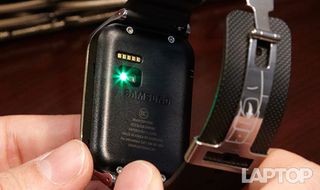
The original Gear had its camera and microphone built into its rigid, nonremovable band, but in the Gear 2, Samsung moved these features onto the watch body, which makes the strap thinner and more flexible. However, we found it difficult to close the clasp. It was also a challenge for us to adjust the size of the band because it required us to move a tiny, metal peg from one hole to another. Fortunately, you can replace the band with any 22mm band on the market, including ones with normal buckles. But for $299, you shouldn't have to.
MORE: Smartwatches: Why Their Time Has Finally Come
Like the original Galaxy Gear, the Gear 2 comes with both silver and copper-colored faces and a variety of strap colors, including black, brown and orange. In an interesting change, the power button is now below the face, rather than on the side. You'll need to press the button to wake up the watch.
In order to charge the Gear 2, pair it with your phone or access its file system on your PC, you must snap a small cradle onto its back. Thankfully, the cradle is much smaller and easier to snap on than the one that came with the Galaxy Gear. However, the Sony SmartWatch 2 has a standard microUSB port built into its body, making it very easy to charge or connect to your PC.
Setup
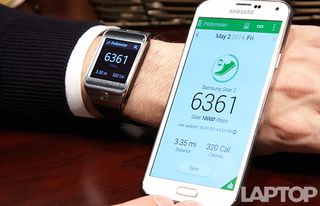
Click to EnlargeIt's fairly simple to get the Gear 2 up and running, provided you have one of the only 17 Samsung-branded phones and tablets that work with it. These include the Galaxy S3, Galaxy S4, Galaxy S5, Galaxy Note 2, Galaxy Note 3 and Galaxy Mega 6.3.
Using a Galaxy Note 3, we downloaded the Samsung Gear Manager from Samsung's app store and followed its directions as it walked us through a simple Bluetooth pairing with the watch. We did not have to change any settings after that to start using the watch, but Gear Manager offers many options.
Smartphone App
Click to EnlargeUsing Gear Manager, we were able to change the phone's wallpaper from its default multicolor design to an attractive purple one (you can use any image you want), install/remove third-party apps and control notifications. The Find My Gear feature made it easy to locate the watch; hitting a button caused the watch to start playing a loud sound.
Notifications
Click to EnlargePerhaps the best reason to use a smartwatch is to receive alerts on your wrist so you don't have to whip out your phone every time someone messages or calls you. Using the Gear Manager app on our phone, we selected which of our installed apps could send alerts to the watch. The list of available apps included every notification-enabled program on our phone, from Facebook and Twitter to Google Plus and LinkedIn.
When we received alerts either from Gmail or our corporate Exchange account, the Gear 2 buzzed on our wrist and showed us how many messages had arrived. Tapping the icon showed the most recent message, and swiping right to left allowed us to scroll through all messages. The Gear 2 showed about 30 lines of text for the body of each Gmail, which often was enough to get the entire message.
For non-Gmail email, the watch showed the entire message. The device loaded portions of the text as we scrolled farther down. Photos and other email attachments were not visible, but if we tapped the Show on Device button at the bottom of each email on the watch, it would open the full message on our phone or, in the case of Gmail, open the inbox. The Facebook app alerted us to incoming direct messages but not to likes on our posts.
MORE: 5 Reasons You Will Wear a Smartwatch
If we missed a notification or just wanted to see all of our recent notifications in the same place, we tapped the notifications icon in the watch user interface and saw a list of every app that had alerted us recently: email, Gmail, phone calls, SMS messages and Facebook. When we tapped on an app shortcut, we saw an inbox of all recent notifications from that app, which we could then tap on to view individual messages.
When calls came in, the Gear 2 showed the caller ID and gave us the option to either accept or reject the call. If we accepted the call, the speaker and microphone on the watch turned on, so we could conduct the entire call from our wrist. (If the Gear 2 is paired with a Bluetooth headset, the call takes place on that instead.) If we rejected a call, we were given the option to send one of several preloaded call-rejection text messages.
The watch shows entire text messages and also allows you to respond or call the sender directly from the Gear 2. We had the option to reply with one of half a dozen canned messages -- such as "How's it going?," What's up?" and "I'll talk to you soon" -- or we could dictate the response via S Voice.
Operating System and UI
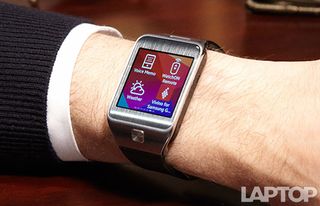
Click to EnlargeThe Gear 2 runs Samsung's Tizen OS rather than the modified version of Android it used on the original Galaxy Gear, but the user interface is nearly identical. When you first open the watch, it shows the face, which displays the time and either a few app shortcuts or the weather, depending on which face you choose. Swiping to the right or left shows you screens, each with a single shortcut to one of 17 preloaded apps. These options include the Voice Memo app, Dialer, Notifications, Camera and Contacts.
Tapping the Apps icon takes you to a list of all apps, with four shortcuts displayed per screen. You can also add apps to the top level by long-pressing their icons and dragging them onto the home screen.
Swiping down from the top of the Gear 2's display always takes you back a step, eventually bringing you back to the watch face. Double-tapping on the screen with two fingers shows the battery and Bluetooth status, along with brightness and volume sliders.
On the original Galaxy Gear, swiping down from the face took you directly to the camera, and swiping up took you directly to the dialer, but unfortunately, those shortcuts don't exist on this watch. However, in Gear Manager, you can configure the power button to launch any app you want with a double tap. Hitting the power button once either wakes the watch or puts it to sleep.
Overall, we found that, with so many apps at the top level, it took a lot of swipes to get to the activities we wanted, whether it was the phone dialer or a third-party app we had installed. By the time we got to our contacts list and selected someone to call, we probably could have taken out our phone and done the same.
Screen and Watch
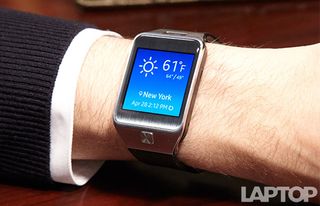
Click to EnlargeThe Gear 2's 1.6-inch 320 x 320-pixel display provided bright, sharp and colorful images. However, to view the screen easily outdoors, we had to pump the brightness all the way up to Outdoor Mode.
Unfortunately, as with the original Galaxy Gear, the Gear 2's screen turns off after a few seconds of inactivity and remains completely dark until you either receive another alert, hit the power button or hold the watch up to your face.
Other smartwatches show their faces at all times. The Pebble and Pebble Steel accomplish this via an e-paper display. The Sony SmartWatch 2 has a color display but goes into gray-scale mode while sleeping.
We found the lack of an always-on face on the Gear 2 extremely annoying. When we wanted to simply see the time, we couldn't just look down at our wrist. Instead, we had to lift the watch up to our face and wait about a second for it to wake up. Not only did that gesture take too much time, but it also forced us to be indiscreet in social situations -- everyone could see we were raising the watch to check the time.
Health Features and Heart Rate
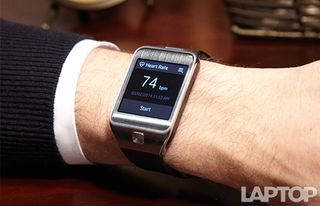
Click to EnlargeIf you're fitness-minded, the Gear 2 has a number of features designed for you. The watch's built-in heart-rate monitor can measure your beats per minute on demand. It took a good 20 to 30 seconds each time to register our heart rate -- slower than most health bands.
The watch has a built-in pedometer that you can use with either the built-in pedometer app or the exercise app, which times one of four types of workouts: running, walking, cycling or hiking. When you're finished, you also get a count of the calories you burned. When we were running with the exercise app on, it rechecked our heart rate several times a minute.
If you're willing to wear the Gear 2 to bed with you, the sleep app can measure how many hours you've dozed, but not the type of sleep you've experienced. There's also a stopwatch app.
Camera
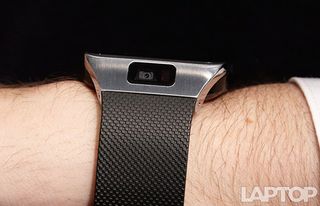
Click to EnlargeThe watch's camera captures photos at up to 1920 x 1080 pixels and videos at 1280 x 720p for as long as 15 seconds. However, we wouldn't recommend doing any serious photography with the Gear 2. Images and a video we shot of a busy street were bright and relatively sharp but whitewashed. Low-light pictures were nearly impossible to see. (Check out sample images in our gallery above.)
If you were hoping to take some stealth shots of people acting strangely on the subway, you probably don't want to use the Gear 2, because it makes a loud shutter noise while shooting. On the bright side, your images get transferred directly to the phone, so you can easily edit and share them. We wish the camera faced forward rather than out so we could use it for selfies or video chats.
[sc:video id="1leXE1cTr18asFlv2u3DQnmvzGWOmUE_" width="575" height="398"]
Call Experience
When we called a friend using the watch, her voice was loud and clear; she reported that our outgoing audio was also accurate. However, we would recommend using the watch as a phone when you're in a private space like your car or a closed office, as walking down the street while talking seems awkward.
Voice Control
Like its predecessor, the Gear 2 comes preloaded with Samsung's S Voice assistant, which works for some basic tasks but won't make anyone forget Google Now or Siri. Like S Voice on the phone, all of the watch's speech recognition and answers are cloud-based, so we often had to wait quite a while (10 seconds or more) for a reply.
The watch had answers for a few basic questions, but not for many others. When we asked, "Who is the president of the United States?" it read us back "Barack Hussein Obama." The Gear 2 also correctly gave us the current time in Taipei. However, the watch did not have a reply when we asked, "What was Russell Crowe's last movie?", "Did the Yankees win?" and "Who won the Oscar for best actor?".
S Voice worked correctly when we asked it to "Call Liz" and dialed the only person named Liz in our contact list. However, later, when we asked the Gear 2 to "text Liz," it picked the wrong person from our address book. We wouldn't recommend using S Voice to call contacts from your address book, because the convenience is not worth the risk of calling the wrong person.
Music Playback
If you like to jog without your phone in your pocket, you can still enjoy music with the Gear 2. If you copy MP3s onto the watch's 4GB of internal memory, you can use the included Music Player app to play those songs back, either using the watch's speaker or a paired Bluetooth headset. You can also go back and forth through music that lives on your phone by using the Media Controller app.
Remote Control
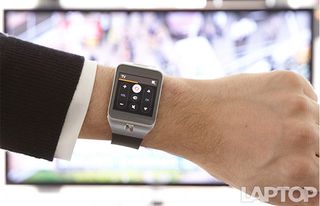
Click to EnlargeThe Gear 2 comes with a built-in infrared port and WatchON remote-control app that makes it easy to change channels on your TV. After quickly choosing our brand of TV and cable provider, the app allowed us to change channels, adjust the volume, mute and turn both devices on and off. There's no number pad, no channel guide and no ability to control other devices like you can on the smartphone version of WatchON, but if your regular remote and handset are both out of reach, you'll appreciate being able to use your watch for this purpose.
Apps
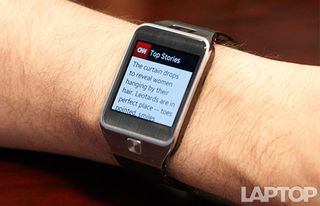
Click to EnlargeBecause Samsung switched from Android on the Galaxy Gear to Tizen on the Gear 2, any apps that were written for the original Gear won't work on the new model and vice versa. Samsung's app store features about 100 apps for the Gear 2, but most of them are watch faces, and we could count the number of interesting, useful apps on one hand. In comparison, the Pebble has more than 1,000 apps, and the Sony SmartWatch has more than 300.
The apps are divided into seven categories: Entertainment, Finance, Health/Fitness, Lifestyle, Social Networking, Utilities and Clock. Our favorite of these is the CNN app, which shows the latest headlines and short articles, but without images. The eBay app provides alerts about items you've bid on or new items that match a search query. Feedly shows headlines and images from your favorite RSS feeds, and gives you the option to open them on your phone. Life360 has an app for its family locator service.
Battery Life
In anecdotal use, the Gear 2 lasted a couple of days on a charge. The watch drained about 20 percent in just 5 hours of frequent use, so we estimate it would last about two days of light use and one day of heavy use before needing a charge.
Bottom Line
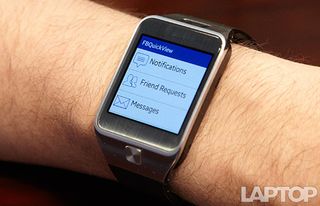
Click to EnlargeThe Gear 2 offers a smorgasbord of features, including a camera, the ability to make calls, a heart-rate monitor, apps and a remote control. While all of these features are useful, the main purpose of any smartwatch is to provide key information at a glance so you don't have to whip out your phone. The Gear 2's alerts are quick and detailed, but most of its other capabilities were several swipes away from the home screen and not as useful as the equivalent apps on our phone. You should expect more for $299.
Because its face goes dark after a few seconds and requires either a button press or a wrist gesture to wake it up, the Gear 2 fails as a timepiece, and because its band is hard to close, it disappoints as a watch. Users who want a watch that's great for notifications and apps should consider the $149 Pebble or the $249 Pebble Steel, which has 1,000 apps and stays awake so you can see the time at a glance. If you're an early adopter who likes the idea of a watch that makes calls, takes photos and runs apps, the Gear 2 might be for you, but only if you're willing to pay more than it's worth.
Samsung Gear 2 Specs
| Company Website | http://www.samsung.com |
| Size | 2.3 x 1.45 x 0.39 inches |
| Weight | 2.4 ounces |
